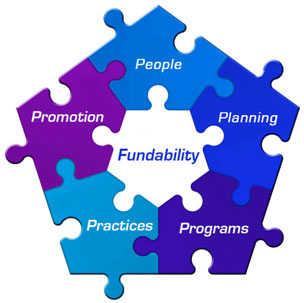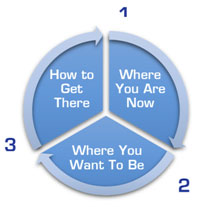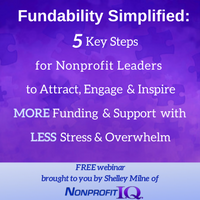What do you think nonprofit leaders identify as the most common obstacles to success and sustainability? Recently, I conducted a survey asking executive directors, management level staff, and board members from small to mid-sized nonprofits about their greatest challenges. I’m sure it will come as no shock that lack of funding topped the list of challenges. This was then followed by E.D. and board issues and then staff-related challenges.
 We all want organizations that are positioned for success and long-term sustainability, right? So, why do so few charitable nonprofits achieve that lofty goal? Allow me to share some insights that I’ve gleaned over the past 25 years of studying the UNIVERSAL PRINCIPLES AND SCIENCE OF SUCCESS, as well as more than two decades that I’ve devoted to helping organizations of all shapes and sizes create NONPROFIT EXCELLENCE. During that time, I’ve learned from hundreds of nonprofit leaders, experts, thought leaders, and funders to create a step-by-step system and process to help nonprofit leaders create strong, sustainable organizations that are powerfully positioned for ongoing success and sustainability. We call our system the FUNDABILITY FORMULA. But, before getting into what the Fundability Formula is, it’s important to understand why I developed this system.
We all want organizations that are positioned for success and long-term sustainability, right? So, why do so few charitable nonprofits achieve that lofty goal? Allow me to share some insights that I’ve gleaned over the past 25 years of studying the UNIVERSAL PRINCIPLES AND SCIENCE OF SUCCESS, as well as more than two decades that I’ve devoted to helping organizations of all shapes and sizes create NONPROFIT EXCELLENCE. During that time, I’ve learned from hundreds of nonprofit leaders, experts, thought leaders, and funders to create a step-by-step system and process to help nonprofit leaders create strong, sustainable organizations that are powerfully positioned for ongoing success and sustainability. We call our system the FUNDABILITY FORMULA. But, before getting into what the Fundability Formula is, it’s important to understand why I developed this system.
The Great Nonprofit Conundrum
Understandably, most small to mid-sized nonprofits seem to focus the vast majority of their time, energy, and effort on funding issues. It certainly seems logical. If you don’t have enough funding, do what you can to get more. But, let me ask you an important question:
Are funding challenges the root cause of your problems or are they a symptom of one or more complex issues in your organization?
I’d like you to really give some thought to this because I propose that in almost every instance, a lack of funding is a mere symptom of problems or deficits in other areas. I’d like to offer you an alternate way of looking at how we see and address our funding challenges.
In college, I studied nonprofit effectiveness and leadership from a systems theory perspective. I learned to evaluate a nonprofit’s effectiveness, looking at an organization as a system of interdependent parts or subsystems that when working together well, create a strong, vital organization. Conversely, when any of these parts are deficient, defective or entirely missing, the system breaks down and problems emerge. These problems are very often cleverly disguised as funding challenges or perhaps interpersonal issues amongst leadership, staff, volunteers, etc. Does this sound familiar?
After working in a variety of capacities within the nonprofit field over the years, I eventually fell into grant development work. I was able to combine my educational training with my practical experience working in many different aspects of the nonprofit field helping organizations become healthier, and therefore more attractive to funders. Rather than wasting time writing grant requests that were unlikely to get funded, I’d analyze the component pieces of the organization that funders are looking at when they’re analyzing the strength and long-term viability of a potential grantee – this is what I call an organization’s “fundability.” I’d help my clients identify and work on the things that needed “fixing” or create a plan to do so. Only when we were ready, would we go after the funding… typically with a much better result.
Nonprofit “Natural Selection”
 Relax, I’m not here to argue Evolution vs. Creation! I will contend, however, that Charles Darwin’s Survival of the Fittest Theory applies to nonprofit businesses as well as to nature. It’s true that strong and healthy organizations are more likely to survive, but consider this as well. Darwin’s theory states specifically that, “It is not the strongest of the species that survives, not the most intelligent, but the one most responsive to change.” Change is inevitable. Nonprofits come and go, even those with amazing missions and that are transforming lives, the environment, or otherwise making an important difference in their communities or in the world. Those that anticipate changes and plan for them, are the ones that survive and flourish despite the ever-changing political and economic tides.
Relax, I’m not here to argue Evolution vs. Creation! I will contend, however, that Charles Darwin’s Survival of the Fittest Theory applies to nonprofit businesses as well as to nature. It’s true that strong and healthy organizations are more likely to survive, but consider this as well. Darwin’s theory states specifically that, “It is not the strongest of the species that survives, not the most intelligent, but the one most responsive to change.” Change is inevitable. Nonprofits come and go, even those with amazing missions and that are transforming lives, the environment, or otherwise making an important difference in their communities or in the world. Those that anticipate changes and plan for them, are the ones that survive and flourish despite the ever-changing political and economic tides.
As a professional grantwriter, I learned from the funders themselves that grantmakers are interested in funding organizations that are efficient, effective, and have a solid plan and strategy to take them from where they are now to where they want to be. Funders want to know that the problem(s) the nonprofit is attempting to solve are real with verifiable data, that the organization has strong leadership, is not duplicating services, and are utilizing all available resources effectively. They want to know that the organization has a plan for sustainability after the funding cycle is complete. Grantmakers also want evidence that the services or activities proposed will make a true impact in the community, region, or world. These are some of the factors that contribute to an organization’s fundability.
Fundability Defined
Fundability is a term I use frequently. When I recently asked a group of nonprofit professionals how they define the term fundability, they gave varying answers depending on each person’s particular viewpoint and expertise. In general, however, most gave some variation of the statement below. At Nonprofit I.Q., this is how we define it…

 At its core, fundability is really about attracting, engaging and inspiring people to share their time, talent, and/or financial resources to support your organization’s work. So, this begs the question, how do you do that?
At its core, fundability is really about attracting, engaging and inspiring people to share their time, talent, and/or financial resources to support your organization’s work. So, this begs the question, how do you do that?
The answer to this question is complicated because it differs for various different audiences. For example, how you might attract the interest of a grantmaker to provide funding for a particular program or project is often a very different approach than how you might attract the attention of an individual to donate their personal resources, which also differs from how you would inspire a potential board member to donate their time and talent to support your organization. This is why it’s critically important to know who your audiences are and what they care about… then connect what they value with what your organization does, is, or provides.
Over the past 20 years, the nonprofit field has changed dramatically. Gone are the days that you have a good idea and submit a brief letter to a grantmaker, who then sends a big check. Sure, that can still happen, but it’s pretty rare without some relationship development work on the front end. As funders and supporters become increasingly interested in the impacts that nonprofits are claiming to have and are requiring verifiable proof that their money is being used wisely, nonprofits are being required to provide that evidence. While this certainly creates a LOT more work for the nonprofits, it also helps ensure that nonprofits are actually making the positive impacts that they were hoping to make.
This relatively new focus on accountability is actually a very good thing and will serve to strengthen the nonprofit sector. Ideally, this evidence of effectiveness should be used by all nonprofits to guide their efforts forward and to make necessary changes to improve their impact. Right now, smaller organizations comply because their funders require it. What they fail to realize is that this will eventually become a standard operating procedure, guiding nonprofits toward ongoing improvement and excellence. The quicker they learn to harness the opportunity that these new standards provide, the faster and stronger they’ll see their organizations grow over time.
The Fundability Formula
As a highly visual learner, I think of a nonprofit organization like a big puzzle. There are many pieces that must fit together to create a whole and complete organization. We’ve simplified the concept of fundability by dividing it into five primary pieces, that when working synergistically, create a strong, healthy, adaptable organization. We call this the FUNDABILITY FORMULA, illustrated by the puzzle graphic below.

As we all know, there are many, many parts to creating an effective, efficient nonprofit organization that is positioned for long-term success. Each one of the five primary component pieces can further be divided into more detailed components. However, rather than taking it all on at once, we’ve found it helpful to concentrate on the main areas that need attention first before diving into the details.
 Most leaders of small to mid-sized nonprofits attempt to tackle all of the pieces at once with no structure or process. This leads to stress, overwhelm, and eventually burnout. When this happens, the very work that they were once excited and passionate about becomes a burdensome source of discontent. When we take big jobs piece by piece, chunking the process down into logical, bite sized steps, it becomes manageable and (dare I say) even FUN! Think of it like eating an elephant… you don’t eat the whole thing at once, you take it one bite at a time.
Most leaders of small to mid-sized nonprofits attempt to tackle all of the pieces at once with no structure or process. This leads to stress, overwhelm, and eventually burnout. When this happens, the very work that they were once excited and passionate about becomes a burdensome source of discontent. When we take big jobs piece by piece, chunking the process down into logical, bite sized steps, it becomes manageable and (dare I say) even FUN! Think of it like eating an elephant… you don’t eat the whole thing at once, you take it one bite at a time.
Below, we’ve identified a few key components for each of the five steps in the Fundability Formula to give you a glimpse of each of the steps.
 People – The Heart & Soul of Your Nonprofit
People – The Heart & Soul of Your Nonprofit
How do you attract more funding and support for your organization or cause? It all begins with great leadership, followed by a strong and engaged “team” of committed ambassadors to leverage time and energy of the organization’s leadership.
 Planning – The Foundation for Sustainable Success
Planning – The Foundation for Sustainable Success
Assessing the strengths and resources as well as the problems and deficits of an organization is a critically important starting point. You must know where you’re starting from in order to get there in the quickest, most efficient way possible. Once you’ve identified where you are now, you need to clarify exactly where you want to be and by when. Finally, you create a solid strategy and an action plan to get you from here to there.
 Programs – Solving Problems & Making a Powerful Impact
Programs – Solving Problems & Making a Powerful Impact
What are the problems that your organization is trying to solve, who are the primary and secondary beneficiaries that will be affected by this change, and what programs and/or services are necessary to create this change? Who are the people that need to be at the collective table that may have the knowledge, skills, people, or other resources that are best positioned to help achieve your goals? What is the impact you plan to achieve and how will you measure it?
 Practices – Systems to Support Long-Term Success
Practices – Systems to Support Long-Term Success
Is your nonprofit optimized in terms of governance, fundraising and resource development, financial systems, staffing, and administration? What systems need to be implemented to create the most efficient, effective use of your nonprofit’s various human and financial resources? What policies and procedures need to be addressed to ensure compliance with various local, state, and federal laws and guidelines?
 Promotion – Strategizing Your Communications
Promotion – Strategizing Your Communications
You need strategies to communicate with key audiences about who you are, what you do, how you do it, and why your work is so critically important. A comprehensive communication strategy targeted to your specific audiences will help to cultivate, engage and inspire your support team and your greater network of supporters. What communication best practices will keep them interested in becoming increasingly involved over time?
Nonprofit Success – Simplified
 In its simplest terms, organizational success becomes possible and much easier to attain when you are crystal clear on the following three things:
In its simplest terms, organizational success becomes possible and much easier to attain when you are crystal clear on the following three things:
- Where you are currently
- Where you want to be and by when
- How you will get there
Think about nonprofit success as being like a road trip to your favorite vacation destination. You have to know where you’re  starting from and know where you’re going in order to get there. Even a GPS can’t find the quickest route if you don’t give it the data it needs to determine the most efficient way.
starting from and know where you’re going in order to get there. Even a GPS can’t find the quickest route if you don’t give it the data it needs to determine the most efficient way.
If you’re missing any one of these steps, you’ll have great difficulty engaging your staff board, getting volunteers and funders to support your organization, plus you’ll find it nearly impossible to retain their interest in your organization.
Proactive vs. Reactive Leadership
When the leadership team of a nonprofit spends the time to plan in this thoughtful and collaborative process, it can completely transform the energy and create renewed enthusiastic support amongst staff and board members. It’s important to include the ideas and thoughts of staff, even those that may not be involved with the strategy planning process itself.
 Failure to participate in such an inclusive and proactive planning often results in the organization being forced to continually operate in a reactive mode; constantly responding to unforeseen issues and challenges which makes it difficult or even impossible to evolve and grow. Think about it. If we don’t know where the target is, hitting a bullseye is pretty unlikely. When organizations fail to create a collective plan and a strategy, each staff and board member has a different vision for what he or she wants and expects from the organization. This is a recipe for big, ugly problems!
Failure to participate in such an inclusive and proactive planning often results in the organization being forced to continually operate in a reactive mode; constantly responding to unforeseen issues and challenges which makes it difficult or even impossible to evolve and grow. Think about it. If we don’t know where the target is, hitting a bullseye is pretty unlikely. When organizations fail to create a collective plan and a strategy, each staff and board member has a different vision for what he or she wants and expects from the organization. This is a recipe for big, ugly problems!
Conversely, when you create a shared vision for where you want your organization to be in the future and how you’re going to get there, this creates a synergy amongst staff and board members, an excitement and enthusiasm about the future, and often a renewed commitment and energy to work cohesively in order to reach your shared goals. This is the foundation of how successful nonprofits grow responsibly and sustainably.
Sustainability
Focusing on your nonprofit’s fundability is essential if you want to attract the funding and support  necessary to sustain and to grow your programs in order to serve your clients, constituents or community at the level you are truly needed. Continuous attention on these five steps of fundability will lead your organization to the most desired of all places in the nonprofit field: retention of donors and other supporters, continual growth, and sustainability. Being able to sustain your programs and services at the level that your organization is truly needed is the key to success for your organization. When you take it step-by-step, the workload is lighter and the journey becomes much more enjoyable.
necessary to sustain and to grow your programs in order to serve your clients, constituents or community at the level you are truly needed. Continuous attention on these five steps of fundability will lead your organization to the most desired of all places in the nonprofit field: retention of donors and other supporters, continual growth, and sustainability. Being able to sustain your programs and services at the level that your organization is truly needed is the key to success for your organization. When you take it step-by-step, the workload is lighter and the journey becomes much more enjoyable.
Do You Want More?
 Regardless of whether your nonprofit is struggling to survive or if you’re doing pretty well, but want to serve at a higher level, or somewhere in between, Nonprofit I.Q. can help. If you haven’t already signed up to receive Nonprofit I.Q.’s Hot Freebies, we have some great tools and resources to get you started. When you sign up, you’ll also be added to our mailing list so you’ll be amongst the very first to receive information on new trainings, tools and resources designed to help your nonprofit become more efficient, effective, and fundable… and to help YOU position your organization for ongoing success and sustainability. Here’s what you get when you sign up:
Regardless of whether your nonprofit is struggling to survive or if you’re doing pretty well, but want to serve at a higher level, or somewhere in between, Nonprofit I.Q. can help. If you haven’t already signed up to receive Nonprofit I.Q.’s Hot Freebies, we have some great tools and resources to get you started. When you sign up, you’ll also be added to our mailing list so you’ll be amongst the very first to receive information on new trainings, tools and resources designed to help your nonprofit become more efficient, effective, and fundable… and to help YOU position your organization for ongoing success and sustainability. Here’s what you get when you sign up:
![]() Fundability Report Card – A simple assessment to help you identify the areas that your nonprofit should prioritize time and energy to attract the funding and support needed for ongoing success.
Fundability Report Card – A simple assessment to help you identify the areas that your nonprofit should prioritize time and energy to attract the funding and support needed for ongoing success.
![]() Nonprofit Inspirations – Email subscription to Nonprofit I.Q.’s blog on the inner and outer game of success. Learn ideas and strategies to help you create maximum impact and serve your clients and communities more effectively.
Nonprofit Inspirations – Email subscription to Nonprofit I.Q.’s blog on the inner and outer game of success. Learn ideas and strategies to help you create maximum impact and serve your clients and communities more effectively.


